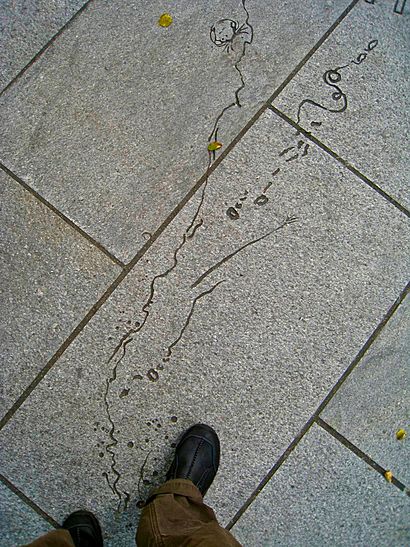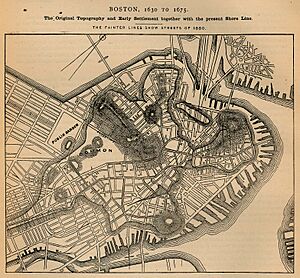A Once and Future Shoreline facts for kids
A Once and Future Shoreline is a special public artwork in Boston, Massachusetts. It's a long line etched into the granite ground near the famous Faneuil Hall building. This artwork shows exactly where the edge of Boston Harbor was around the year 1630.
The artwork is 850 feet long. It uses etched pictures of things you'd find at the high tide line, like seaweed and shells. It helps you imagine how this busy city spot used to be a salty marsh by the sea.
Discovering Boston's Old Shoreline
The area where this artwork is located was once a very important landing spot called Town Dock. This was one of the first places ships landed in Boston Harbor. Over many years, starting in the 1600s, people filled in parts of the harbor to create more land. This process is called "wharfing out." The old dock area then became known as Dock Square.
The idea for A Once and Future Shoreline came from a lot of research. Experts looked at old maps and historical writings to figure out where the shoreline used to be. This artwork helps everyone see a piece of Boston's original coastline right in the middle of the city.
What You Can See in the Design
The artwork shows the old high-tide line by cutting shapes into the granite. These shapes look like things you would find washed up on a beach. You can spot sea grass, seaweed, skate egg cases, different kinds of shells like quahog and blue mussels, feathers, and even pieces of old rope.
The plaza's paving also shows more history. It has a pattern from an 1820 map of the area. Grey granite blocks show old street layouts. Pink granite blocks with etched dash lines mark where buildings stood back then. The artwork is also next to a sculpture of Samuel Adams by Anne Whitney.
Boston's Changing Landscape
The land where this artwork sits is now far from the ocean's edge. But about 5,000 years ago, the ocean was even further inland! At that time, early native people lived on grassy plains and hills that are now under the water of Boston Harbor.
This artwork reminds us that shorelines can change. Scientists believe that rising ocean levels, due to global climate change, could one day bring the ocean back to this very spot. It makes you think about how much our world can change over time.



